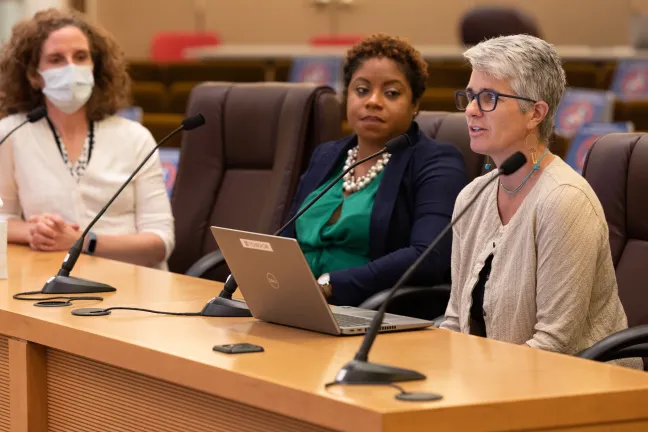Health Department officials briefed Multnomah County commissioners on the latest COVID-19 trends Tuesday, Aug. 30, just as students began returning to the classroom. The transition into fall also marks the beginning of the traditional respiratory illness season in the United States.
The Omicron variant has changed how health officials respond to COVID-19. With high rates of illness and underreporting of cases, the County is no longer viewing the reported percentage of postive cases as a reliable metric. Instead, public health officials are relying on hospital data to track disease activity. And, they note, admissions to the intensive care unit and the number of patients on ventilators have both largely flattened.
“At a population level, we see fewer people needing intensive care relative to the number of people who meet that COVID hospitalization definition,” said Dr. Jennifer Vines, the County’s health officer.
Chantell Reed, the deputy director of the Health Department’s Public Health Division, said the County’s strategy reflects a new phase of the pandemic: living with the virus and moving away from a broad emergency response, with lessons and strategies that can also apply during other pandemics and outbreaks.
“The reality is we have to transition into living with COVID in our community,” Reed said. “This will give us the opportunity to respond to any virus that presents in our community.”
Who is dying from COVID-19?
Hospitalization data shows that waves have occurred roughly in two-month intervals, said Vines. The risk of death increases exponentially with age, with the highest proportion occurring among older men.
The higher death rate among older men is another reason to improve the underlying health of the community through physical activity, nutrition, and reducing drug and alcohol use, Vines added.
While the death rate from COVID-19 has remained relatively low throughout Omicron, the death rate has been highest for people who are unvaccinated. Health officials urge people to stay up to date on their boosters to reduce their risk of severe illness.
Omicron-tailored boosters are expected after Labor Day for everyone 12 and older. The vaccine is expected to be widely available throughout the health system.
“Key point here: Get vaccinated and get your booster,” Vines said.
Heading into the fall, the County’s public health strategy is built around four goals: decreasing mortality among residents who are Black, Indigenous, and People of Color (BIPOC); keeping children in school; continuing outbreak responses in high-risk settings; and continuing to rely on local epidemiology to inform decision-making.
Commissioner Sharon Meieran asked about the death rate among BIPOC residents.
Vines said the State of Oregon stopped conducting intensive case investigations in 2021, which limits reliable race and ethnicity data for COVID-19 cases.
“It’s going to be imperfect, but there is more analysis to come from our (epidemiology) team on this question, knowing that’s of interest,” Vines said.
Keeping kids safe in school
With students returning to the classroom, back-to-school safety is among the County’s top priorities. Promoting vaccinations and masking among students is part of the strategy to stabilize cases.
The state’s threshold for an outbreak is 30% absenteeism, or a cohort—such as a whole kindergarten classroom—plus a confirmed COVID-19 case among those kids who are out. That triggers a notification to parents, which may include masking guidance, information on testing, and mitigation measures.
Commissioner Lori Stegmann asked whether schools require students to wear masks or be vaccinated.
In response, Reed indicated that universal masking will not be imposed. Rather, it would occur on a case by case basis depending on the school.
School employees still need to isolate for at least five days at home if they are infected with COVID-19, and even after five days, they may return only after they have had no fever for 24 hours. There are currently no quarantine requirements for kids or adults who were exposed to someone with COVID-19.
Communicable Disease Services has a dedicated outbreak team with a full-time school and childcare liaison, as well as pediatric disease specialists. The team meets regularly with schools to provide guidance on preventing and mitigating diseases.
Commissioner Susheela Jayapal asked whether masks might be required for students in the future.
“If there’s a new variant that is more severe or somehow more severe in children, that’s a game changer,” said Kim Toevs, who directs the County's Communicable Disease and Harm Reduction programs.

